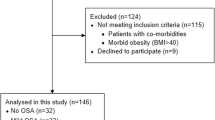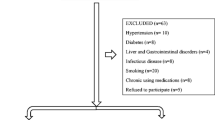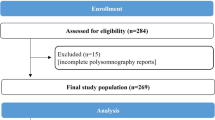Abstract
Purpose
The aim of the present study was to evaluate the serum levels of trace minerals and heavy metals in obstructive sleep apnea (OSA) patients and to investigate whether there is a correlation between levels of trace minerals and demographic and biochemical variables.
Methods
This clinical, case–control study was performed on 61 OSA patients and 36 healthy controls. Demographic, radiological, biochemical variables, as well as serum levels of trace minerals (magnesium, copper, iron, zinc, manganese, cobalt) and heavy metals (lead, cadmium) were compared in OSA and control groups. In addition, correlation of serum levels of these substances to demographic, biochemical, and radiological parameters was tested.
Results
Not only serum levels of cholesterol, triglycerides, cadmium, cobalt, copper, iron, magnesium, manganese, lead, and zinc were found to be higher, but also carotid intima-media thickness (CIMT) was increased in OSA patients. Increase in CIMT was found to be correlated with levels of cobalt, copper, iron, magnesium, manganese, and zinc.
Conclusion
Our results have shown that serum levels of trace minerals and heavy metals were higher in OSA. This difference may ensource from deterioration of the balance of these substances due to oxidative stress and inflammation. Significance of these findings with respect to the etiopathogenesis, diagnosis, and treatment of OSA warrants further trials.


Similar content being viewed by others
References
Vatansever E, Surmen-Gur E, Ursavas A, Karadag M (2011) Obstructive sleep apnea causes oxidative damage to plasma lipids and proteins and decreases adiponectin levels. Sleep Breath 15:275–282
Güven SF, Turkkani MH, Ciftci B, Ciftci TU, Erdogan Y (2012) The relationship between high sensitivity C-reactive protein levels and the severity of obstructive sleep apnea. Sleep Breath 16:217–221
von Kanel R, Natarajan L, Ancoli-Israel S, Mills PJ, Wolfson T, Gamst AC, Loredo JS, Dimsdale JE (2013) Effect of continuous positive airway pressure on day/night rhythm of prothrombotic markers in obstructive sleep apnea. Sleep Med 14:58–65
Volna J, Kemlink D, Kalousova M, Vavrova J, Majerova V, Mestek O, Svarcova J, Sonka K, Zima T (2011) Biochemical oxidative stress-related markers in patients with obstructive sleep apnea. Med Sci Monit 17:CR491–CR497
Vural H, Demirin H, Kara Y, Eren I, Delibas N (2010) Alterations of plasma magnesium, copper, zinc, iron and selenium concentrations and some related erythrocyte antioxidant enzyme activities in patients with Alzheimer’s disease. J Trace Elem Med Biol 24:169–173
Ozturk P, Kurutas EB, Ataseven A (2013) Copper/zinc and copper/selenium ratios, and oxidative stress as biochemical markers in recurrent aphthous stomatitis. J Trace Elem Med Biol 27:312–316
Tapiero H, Townsend DM, Tew KD (2003) Trace elements in human physiology and pathology. Biomed Pharmacother 57:386–398
Sandstead HH, Klevay LM (2000) History of nutrition symposium: trace element nutrition and human health. J Nutr 130:483S–484S
Young VR (2003) Trace element biology: the knowledge base and its application for the nutrition of individuals and populations. J Nutr 133:1581S–1587S
O’Connor JM (2001) Trace elements and DNA damage. Biochem Soc Trans 29:354–357
Ruiter G, Lankhorst S, Boonstra A, Postmus PE, Zweegman S, Westerhof N, van der Laarse WJ, Vonk_Noordegraaf A (2011) Iron deficiency is common in idiopathic pulmonary arterial hypertension. Eur Respir J 37:1386–1391
Rhodes CJ, Wharton J, Howard L, Gibbs JSR, Vonk-Noordegraaf A, Wilkins MR (2011) Iron deficiency in pulmonary arterial hypertension: a potential therapeutic target. Eur Respir J 38:1453–1460
Krachler M, Rossipal E, Micetic-Turk D (1999) Concentrations of trace minerals in sera of newborns, young infants, and adults. Biol Trace Elem Res 68:121–134
Oskarsson A (1993) Risk assessment of essential trace elements—considerations from the Swedish National Food Administration. Scand J Work Environ Health 19(Suppl 1):113–114
Mertz W (1998) Review of the scientific basis for establishing the essentiality of trace elements. Biol Trace Elem Res 66:185–190
Chen PC, Guo CH, Tseng CJ, Wang KC, Liu PJ (2013) Blood trace minerals concentrations and oxidative stress in patients with obstructive sleep apnea. J Nutr Health Aging 17:639–644
Kocyigit A, Armutcu F, Gurel A, Ermis B (2004) Alterations in plasma essential trace elements selenium, manganese, zinc, copper, and iron concentrations and the possible role of these elements on oxidative status in patients with childhood asthma. Biol Trace Elem Res 97:31–41
Darabian S, Hormuz M, Latif MA, Pahlevan S, Budoff MJ (2013) The role of carotid intimal thickness testing and risk prediction in the development of coronary atherosclerosis. Curr Atheroscler Rep 15:306
Conflict of interest
The authors declare no competing interest.
No financial support was received for this paper.
Presentation at a conference
None
Clinical trial registration number
N/A
Author information
Authors and Affiliations
Corresponding author
Rights and permissions
About this article
Cite this article
Asker, S., Asker, M., Yeltekin, A.C. et al. Serum levels of trace minerals and heavy metals in severe obstructive sleep apnea patients: correlates and clinical implications. Sleep Breath 19, 547–552 (2015). https://doi.org/10.1007/s11325-014-1045-2
Received:
Revised:
Accepted:
Published:
Issue Date:
DOI: https://doi.org/10.1007/s11325-014-1045-2




